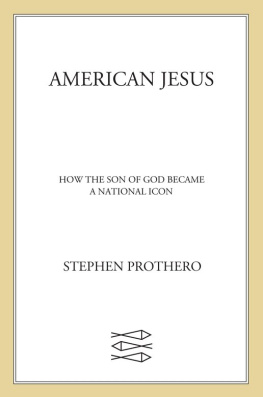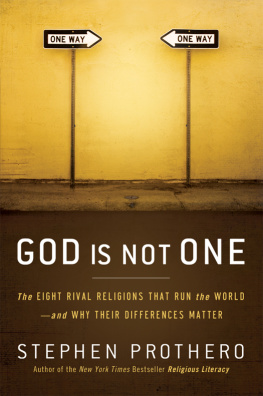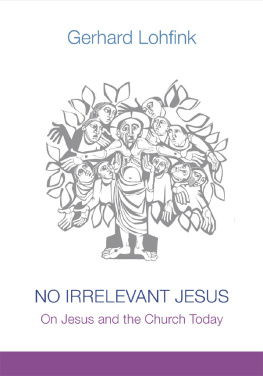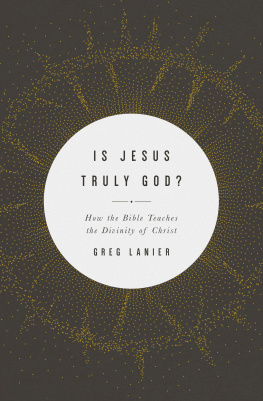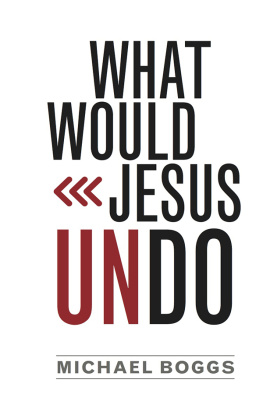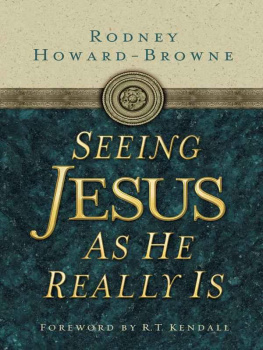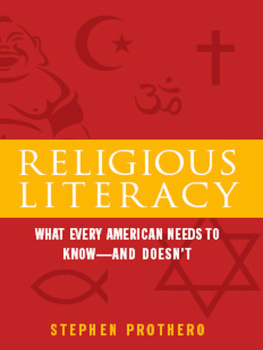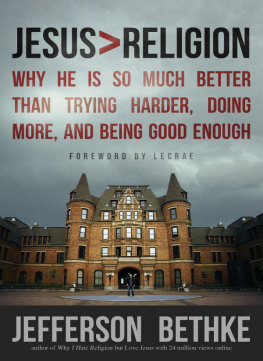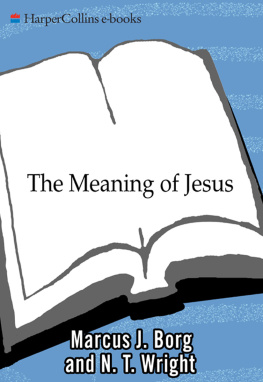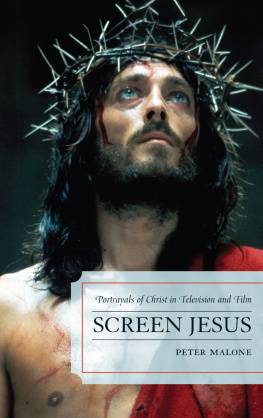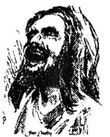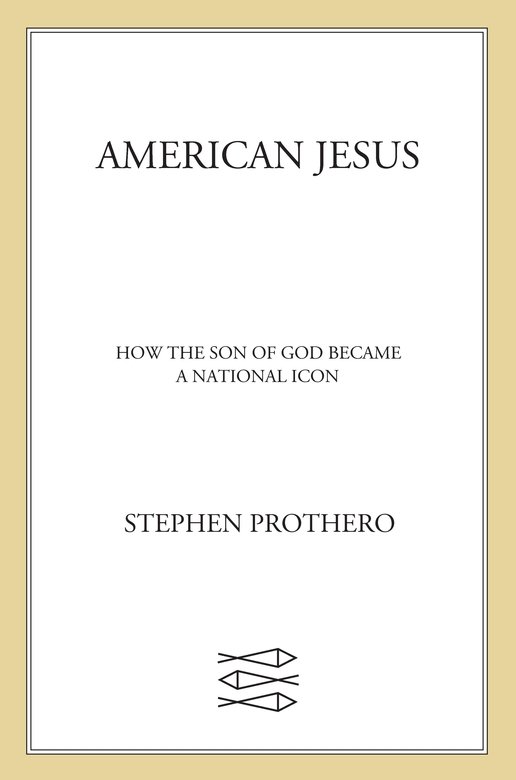
While researching and writing this book, I received help from many generous friends and colleagues. Both David Morgan and Phil Barlow exchanged numerous e-mails and phone calls with me about our shared interests, correcting my mistakes along the way. John Clayton, Harvey Cox, Robert Ellwood, Aaron Garrett, Philip Goff, Matt Hoffman, Kate Holbrook, Jonathan Klawans, Michael McClymond, Colleen McDannell, Dan McKanan, Patrick Quinn Mason, Mark Noll, Jonathan Sarna, Richard Seager, Jan Shipps, Swami Tyagananda, Judith Weisenfeld, and Wesley Wildman all read one or more draft chapters and offered useful comments and criticisms. I also benefitted from discussions (and an occasional argument) with Randall Balmer, David L. Chappell, Yvonne Chireau, Betty DeBerg, Hannah Berliner Fischthal, Georgia Frank, Paula Fredriksen, Edwin Gaustad, Marie Griffith, William Hutchison, Gerald McDermott, Steve Marini, Robert Orsi, Anthony Pinn, Jon Roberts, Leigh Schmidt, Adam Seligman, Mark Silk, John Stackhouse, Jr., Harry Stout, Jesse Todd, and Grant Wacker. Richard Wightman Fox, a former teacher and colleague who is working on a book of his own on Jesus in America, has been an invaluable conversation partner. Julie Koven of the American Jewish Historical Society, Bryan Craig of the Jefferson Library, and Doreen Fast and James Stambaugh of the Billy Graham Center Museum all went out of their way to provide me with expert research assistance. I also received help from the staff at Boston Universitys Interlibrary Loan Office, and at my own Department of Religion and Division of Religious and Theological Studies.
Boston University has allowed me to teach two courses on Jesus in America, and I have profited from interactions with some exceptional students, particularly Lesleigh Cushing, Patton Dodd, Abe Friedman, Crissy Hutchison, Shanny Luft, Mark Mann, Martyn Oliver, Nora Rubel, Michelle Smith, and Emily Wu. I am also grateful for opportunities to discuss my research with students and colleagues at the University of California at SantaBarbara, where I completed this project while working as the Capps Distinguished Visiting Professor in the Walter H. Capps Center for the Study of Religion in Public Life.
My agent, Sandra Dijkstra, and her staff helped to bring the book into being. Paul Elie, my editor, whipped it into shape. Paul is one of the keenest observers of American religion I know, and he has been my most trenchant critic.
I am also grateful for the financial assistance I received from my home university. B.U.s Humanities Foundation, led by Katherine OConnor, provided me a semesters leave when I was first contemplating the book, and a well-timed sabbatical enable me to finish my research.
When asked what her father does for work, my youngest daughter once said, He goes down to the basement and writes his story. For enduring my absences and supporting me throughout, I thank my daughters, Molly and Lucy, and my wife, Edye Nesmith.
Finally, I need to acknowledge my parents, S. Richard and Helen Prothero. From my infancy, they instilled in me a love of learning and curiosity about the Christ Child, the twin engines of this project. I have dedicated this book to them.
Purified by Fire:
A History of Cremation in America (2001)
The White Buddhist:
The Asian Odyssey of Henry Steel Olcott (1996)
In a country where Jesus is as multiform as Proteus, it is difficult to point to any one representation of him and say it is particularly over the top. But the laughing Jesus may fit the bill, particularly because he seems to have been born in a graveyard.
When Dr. Hubert Eaton founded Forest Lawn Memorial Park in Glendale, California, in 1917, his aim was to create a cheerful cemetery. According to Forest Lawns founding myth, Eaton drove out on New Years Day 1917 to a decrepit county cemetery that he was managing. As he surveyed the depressing landscape, he vowed to make it new. He jotted down a statement, part promise and part confession, now memorialized as The Builders Creed. In it, Eaton committed himself to making his cemetery as unlike other cemeteries as sunshine is unlike darkness, as Eternal Life is unlike Death a great park, devoid of misshapen monuments and other customary signs of earthly Death, but filled with towering trees, sweeping lawns, splashing fountains, singing birds, beautiful flowers; noble memorial architecture, with interiors full of light and color, and redolent of the worlds best history and romances. To this vow he appended a three-partcreed to cheerful Christianity: I believe in a happy eternal life. I believe those of us left behind should be glad in the certain belief that those gone before, who believed in Him, have entered into that happier Life. I believe, most of all, in a Christ who smiles and loves you and me.
Over the next few decades, Eaton transformed Forest Lawn into one of the largest and most profitable cemeteries in the United States. He replaced tombstones with memorial markers flush to the lawn. He built chapels and hosted weddings of the rich and famous. He also banished from his grounds much of the traditional rhetoric of death, referring to the dead as loved ones and his cemetery as a memorial park. For these efforts, Eaton was brutally satirized by Evelyn Waugh (in The Loved One , 1948) and Jessica Mitford (in The American Way of Death , 1963), both British writers allergic to American cheerfulness. And while many U.S. intellectuals cackled along with their British counterparts, ordinary Americans flocked to the place, making it one of the most popular tourist attractions in southern California. Bruce Barton spoke for many when he praised Forest Lawn as a noble resting place for the departed, and a perpetual delight for those who live. He spoke for Eaton when he challenged every American cemetery to adopt the Forest Lawn approach. Not until that happens will we be able to call ourselves a truly Christian nation, Barton wrote. For we worship a Master who loved and laughed who, on the very night before his death, could say, Be of good cheer; I have overcome the world, and because I live, ye shall live also.
As Forest Lawn expanded from 55 to 300 acres, Eaton filled it with Jesus art, including a reproduction of Leonardo da Vincis Last Supper (in stained glass) and Jan Stykas massive original painting, The Crucifixion . But he still did not have a Christ who smiles. At some point in the early 1950s, Eaton grew tired of his dour Christs. It was a tragic error for Christianity to make of Christ a Man of Sorrows, when He was a loving and smiling Saviour, he wrote. So he announced to the Italian art community a contest with a cash prize for the best portrait of a smiling Jesus. No one took the award home, because none of the entries met with Eatons approval. Many werent even smiling, and those that were possessed, as Eaton put it, a kind of sad look anda definitely European face, Now, what Im looking for,Eaton explained, is a Christ filled with radiance and looking upward with an inner light of joy and hope. I want an American-faced Christ.
George Santayana once wrote that American life is a powerful sot-vent. It seems to neutralize every intellectual element, however tough and alien it may be, and to fuse it in the native good-will, complacency, thoughtlessness, and optimism,
This cosmic optimism, as familiar to Americans as it is foreign to Europeans, failed to produce a Christ who smiles during Eatons lifetime. Henry Ward Beecher had offered his well-to-do congregants at Brooklyns Plymouth Congregational Church a cheerful, companionable, and most winning Jesus. To follow Jesus, he reassured them, was to be the happiest person in the world. In The Man Nobody Knows, Bruce Barton also elevated the pursuit of happiness to a religious goal. God, Barton wrote, was a happy God, wanting His sons and daughters to be happy, and Jesus was the friendliest man who ever lived. But by his death in 1966, Eaton had been unable to locate an artist who dared to deviate so decisively from the Man of Sorrows tradition. In 1987, the Catholic monthly Liguorian found just such an artist in Ralph Kozak, whose rendition of a guffawing Jesus, his headtilted back, roaring with laughter, appeared on its April cover. At the end of the millennium, smiling Jesuses were widespread enough to be spoofed. In the film Dogma (1999), a Catholic cleric committed himself to supplanting old-fashioned crucifixes with an insanely happy Buddy Christ who smiles, winks, and otherwise gives life a big thumbs-up.

